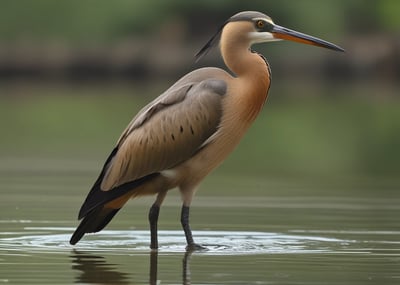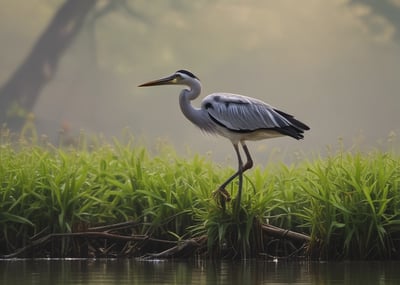🔥 Sundarban 2N/3D Package Just ₹8500! | Free Unlimited Alcohol 🍻 | Pickup & Drop from Kolkata 🚗 | Book Now – Call: 9836626227 📞 | Bongo Yatra
Birdwatching in Sundarbans: A Paradise of Migratory Birds in the Delta of Bengal | Bongo Yatra
Immerse Yourself in an Unforgettable Birdwatching Experience in the Mangrove Forests of Sundarbans. Witness a wide variety of local and migratory birds in their natural habitat. Plan your birdwatching adventure with Bongo Yatra and explore the wild beauty like never before.
Ravi S Mishra CEO - Kaka Enterprises Email - ceo@kakaenterprises.in
6/25/20254 min read


Birdwatching in Sundarbans: A Paradise of Migratory Birds in the Delta of Bengal | Bongo Yatra
Immerse Yourself in an Unforgettable Birdwatching Experience in the Mangrove Forests of Sundarbans.
Witness a wide variety of local and migratory birds in their natural habitat.
Plan your birdwatching adventure with Bongo Yatra and explore the wild beauty like never before.
Keywords: *Sundarban Birdwatching* *Sundarban Birds* *Sundarban Bird Sanctuary* *Sundarban Migratory Birds* *Birds in Sundarban* *Bengal Delta Birds* *Sajnekhali Birds* *Mangrove Birds* *Bongo Yatra Birdwatching* *Sundarban Wildlife Photography* *Bengal Tourism Birdwatching* *Sundarban Eco-Tourism*
Birdwatching in Sundarbans: A Hidden Heaven of Feathers in the Delta of Bengal
When we think of the Sundarbans, the first image that usually comes to mind is that of the majestic Royal Bengal Tiger. Indeed, spotting the king of this delta is an unforgettable experience—but the Sundarbans hold another, equally magical world: the world of birds.
This vast region is not just the tiger’s home; it is also a hidden paradise for bird lovers who wish to witness the beauty and diversity of avian life up close. The dense mangrove forests and intricate river network of the Bay of Bengal’s delta provide an ideal habitat and sanctuary for thousands of resident and migratory birds.
Imagine This Scene
It’s a quiet morning. Your boat gently glides through narrow mangrove channels. Above you, vibrant birds soar through the sky. Kingfishers, eagles, and herons rest on branches, while their melodious calls blend with the breeze. This is the soul-soothing experience that birdwatching in the Sundarbans offers—an intimate connection with nature like no other.
Bongo Yatra is ready to take you deep into this avian paradise, where every moment reveals a new discovery and every bird tells a unique story.
Sundarbans: A Unique Ecosystem of Bird Diversity
Thanks to its unique geography and rich mangrove ecosystem, the Sundarbans offer an ideal environment for birdlife. A blend of saline and freshwater, dense forests, and open wetlands attract a wide range of bird species.
Why Mangroves Matter for Birds
Mangrove trees—with their complex root systems—offer safe nesting spaces, protection from predators, and abundant food sources like fish, insects, and reptiles. Their layered branches and leaves create perfect cover for hunting and shelter.
Resident Birds in Abundance
The Sundarbans are home to many local bird species, including:
Kingfishers: Species like the Black-capped, Brown-winged, Stork-billed, and Pied Kingfishers are commonly seen fishing along riverbanks.
Herons and Egrets: Indian Pond Heron, Great Egret, Little Egret, Grey Heron, and Purple Heron are often spotted wading near the water’s edge.
Birds of Prey: White-bellied Sea Eagle, Grey-headed Fish Eagle, and Brahminy Kite are often seen soaring or perched on tall trees.
Other Birds: Woodpeckers, Mynas, Finches, Sandpipers, and various types of cuckoos are also common in this region.
A Migratory Bird Haven
During the winter months (November to February), the Sundarbans turn into a vital winter refuge for thousands of migratory birds arriving from colder regions like Siberia, Europe, and Central Asia.
Examples: Arctic Tern, Eurasian Curlew, Green Sandpiper, as well as numerous species of ducks and waders.
A Festival of Biodiversity: The arrival of these birds enriches the region’s biodiversity and offers stunning spectacles for birdwatchers.
How to Experience Birdwatching in the Sundarbans
Birdwatching here is a peaceful, deeply rewarding activity that requires patience and the right gear.
1. Boat Safari: The Best Way to Watch Birds
Stable Platform: Boats offer a comfortable and steady base for observing birds along the banks and within the mangroves.
Slow Movement: Slow cruising gives you ample time for spotting and photographing birds.
Ideal Time: Early mornings and late afternoons are the best times when birds are most active.
2. Top Birdwatching Spots
Sajnekhali Bird Sanctuary: The most renowned site for birdwatching in Sundarbans, featuring a watchtower and a mangrove interpretation center.
Gazikhali and Choragajha: Lesser-known areas rich in avian diversity.
Creeks and Hidden Channels: Remote, narrow waterways often lead to sightings of rare birds where tourist boats rarely go.
3. Essential Gear
Binoculars: A good pair helps spot and identify birds from afar.
Camera with Telephoto Lens: For photography enthusiasts, a DSLR or mirrorless camera with a 300mm+ lens is essential.
Field Guide: A bird guidebook (India or Sundarbans-specific) helps in identifying what you see.
Notebook and Pen: To log your bird sightings.
4. Birdwatching Tips
Patience is Key: Birds won’t always appear instantly.
Stay Quiet: Avoid noise; do not disturb the birds.
Dress Smart: Wear neutral, earthy tones that blend with the surroundings.
Hire a Guide: A local guide or naturalist knows the birds and their behaviors best.
Planning Your Birdwatching Trip with Bongo Yatra
When to Go
The best birdwatching season in the Sundarbans is between November and March.
Migratory Birds: Peak numbers are seen between December and February.
Pleasant Weather: Calmer waters and cooler temperatures make for a comfortable journey.
How to Reach
From Kolkata to Canning: Local trains run from Sealdah to Canning.
Canning to Godkhali: Travel by road (auto/toto) to Godkhali, the main gateway.
From Godkhali: Bongo Yatra's boat takes you into the heart of Sundarbans.
We handle all transport and boat arrangements from Kolkata to your destination.
Where to Stay
Eco-friendly resorts and guesthouses are available, some nestled in mangroves where birdsong can be heard from your room. Overnight boat stays are also possible—a magical experience for any bird lover.
What to Pack
Camera and binoculars
Field guidebook
Light, comfortable clothing (avoid bright colors)
Sturdy footwear
Hat and sunscreen
Insect repellent
Power bank
Notebook and pen
Sustainable Birdwatching in the Sundarbans
Responsible travel is essential in this fragile ecosystem:
Don’t disturb the birds or approach too closely.
Leave no litter—carry your waste back.
Use local guides—they provide authentic insights and support the community.
Never feed wildlife—it harms natural behavior.
Move slowly—let the wilderness reveal itself naturally.
Why Choose Bongo Yatra for Birdwatching in Sundarbans?
Expert Guides: Knowledgeable birdwatching specialists who know where and how to spot rare species.
Custom Birdwatching Packages: Tailored itineraries based on optimal spots and timings.
Safe and Silent Boat Safaris: Ensuring minimal disturbance for maximum sightings.
Community & Conservation Focused: We prioritize sustainability and local support.
All-Inclusive Services: From transport and accommodation to meals—we take care of everything.
Conclusion: Where Birds Sing, and Nature Whispers
The Sundarbans are more than the domain of the tiger—they’re a living, breathing concert of wings and song. For those seeking peace, biodiversity, and deep connection with nature, this is a dream destination.
Whether you're an experienced birder or a curious explorer, the memories of flying feathers, soothing silence, and radiant birds will stay with you forever.
Add Sundarbans to the top of your birdwatching bucket list.
Let Bongo Yatra take you into Bengal’s feathered wilderness.
Contact us today and start your journey to the magical world of mangrove birds.

